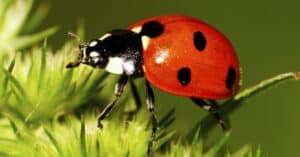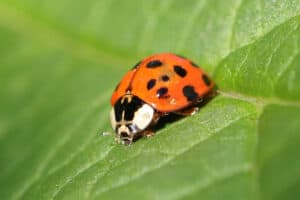Ladybugs are small beetles that belong to the Coccinellidae family. They live almost everywhere in the world and go by other names, such as ladybirds. You’ve probably seen the classic round red beetles with black spots, but ladybugs actually come in a number of colors.
Why Are Ladybugs Brightly Colored?
Ladybugs come in a variety of bright colors, such as red, orange, yellow, blue, and pink. They often have patterns of darker-colored spots, making them beautiful to the eye. These bright colors actually help the ladybugs ward off potential predators.
According to NatureMapping, predators commonly associate bright colors with poisonous creatures, which makes them hesitant to eat ladybugs. But are ladybugs actually dangerous?
For humans, the answer is no. Ladybugs can bite, but this typically causes no more pain than a prick to the skin. Ladybugs do not carry diseases like insects such as mosquitos. In rare cases, people may have allergic and more severe reactions to ladybug bites.
On the other hand, ladybugs do secret a fluid that, while not dangerous to humans, can be harmful to insects, lizards, or birds. Ladybugs can sometimes be poisonous when eaten by animals.
Some researchers believe that a ladybug’s color correlates with its level of toxicity. Research suggests that more brightly colored ladybugs are more toxic. For example, orange ladybugs contain a higher level of toxins in their bodies, while brown ladybugs are considered the least toxic.
1. Tan
Tan is by far the rarest color of ladybug. In 2009 an entomology graduate student at Montana State University named Ross Winton captured an odd new insect. This creature turned out to be a ladybug capable of tucking its head into its throat, writes Reuters.
Winton, who is now a wildlife technician, sent his discovery to scientists in Australia. Only two specimens of this tan, pinhead-sized ladybug have been collected. Entomologists have proposed naming the new species “Winton’s Ladybird Beetle” (Allenius iviei).
Winton’s ladybug differs from the typical ladybug in a variety of ways. For one thing, the insect is only about the size of a grain of sand. They also have the unique habit of slipping their head into their midsection, like a turtle hiding in its shell. So far, it’s not clear why the little creature performs this trick.

One of the only specimens of Winton’s Ladybird Beetle was discovered in Montana.
©Leo_nik/Shutterstock.com
2. White
White ladybugs are beautiful and unique creatures. Only a few ladybug species are white in color, making them quite rare. When looking for a white ladybug, you may spy a creature with a white body and black spots. Several species, such as the twenty-spotted lady beetle (Psyllobora vigintimaculata) have this design.
Other ladybugs have white spots. The cream-spot ladybug (Calvia quattuordecimguttata) gets its name from this feature and its white spots create a lovely contrast with its maroon-brown body.
White ladybugs can be found throughout North America, but they are still quite rare. Seeing one of these creatures is a treat and some people believe that spotting a white ladybug is a sign of good luck. According to Golden Celestial, some people also view the white ladybug as a sign of incoming romance or a symbol of protection over babies.

The cream spot ladybird has a maroon body and white spots.
©Akil Rolle-Rowan/Shutterstock.com
3. Gray
It can be difficult to distinguish between white and gray ladybugs but one species gets its name from its distinctive color. The ashy gray ladybeetle (Olla v-nigrum) can be found throughout Central America, North America, and Oceania.
This species is usually pale gray in color with small, black spots on its elytra and thorax. Like many species of ladybugs, the ashy gray ladybeetle tends to be helpful to humans, as they feed on crop-damaging creatures such as aphids.
The ashy gray ladybeetle also has an interesting color variation. While its typical appearance is gray with black spots, one color variation of the species is black with two red spots. This variation appears quite similar to the “twice-stabbed” beetle (Chilocorus orbus).
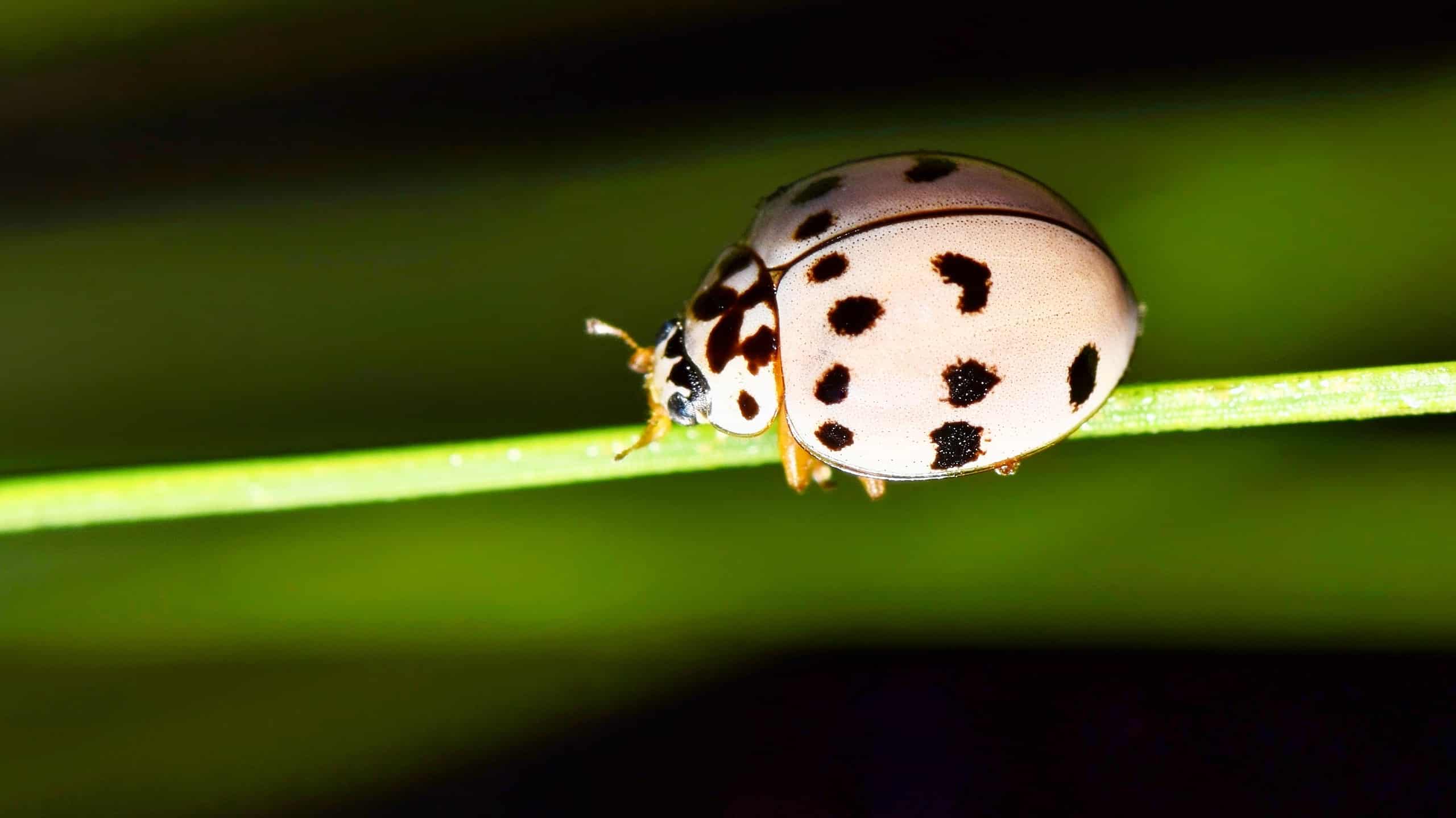
The ashy gray lady beetle sometimes has a pinkish-gray color and black spots.
©Brett Hondow/Shutterstock.com
4. Pink
Pink ladybugs are relatively uncommon, but they are a stunning sight to see. The pink spotted ladybeetle (Coleomegilla maculata) is oblong in shape with a light pink hue and black spots. They are typically found in the warmer regions of North America, such as its southern and eastern portions.
According to Roaring Nature, the pink coloration is the result of a genetic mutation that causes a lack of melanin in their exoskeleton. Other ladybug species present color variations that make them appear pink. For example, the ash-gray ladybug sometimes takes on a pinkish-gray hue.
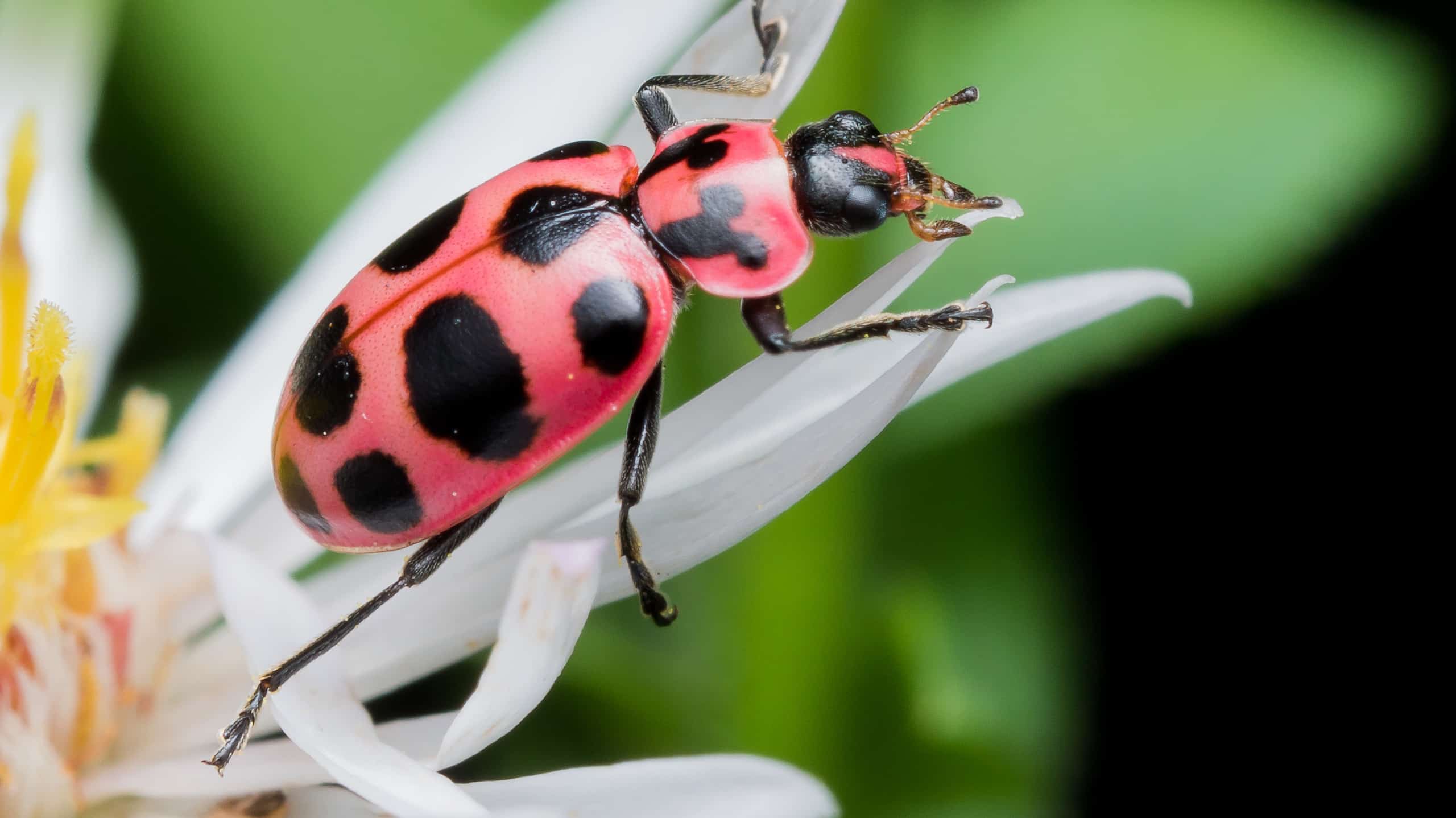
The pink-spotted ladybeetle belongs to the large family of ladybugs and resembles the seven-spotted ladybug in many ways.
©Steven Ellingson/Shutterstock.com
5. Blue
Steelblue ladybugs (Halmus chalybeus) are quite a sight to see. The species is native to Australia and can only be found on this continent and in New Zealand. Steelblue ladybugs were introduced into New Zealand in 1899 and according to Landcare Research, are now widespread in the North Island.
As their name suggests steel blue ladybugs are stunning creatures with a metallic dark blue or greenish color. Unlike many other ladybugs, this species does not have spots.

Steel blue ladybugs are metallic blue or greenish in color.
©Daria Trefilova/iStock via Getty Images
6. Brown
Ladybugs are typically known for being brightly colored. Their beautiful patterns and hues delight humans, but also warn predators to stay away. This defense works because many predators associate colors like red and orange with poisonous creatures.
However, some ladybugs do not feature such stunning colorations. In fact, there are several species that are plain brown. While brown ladybugs aren’t the rarest, their color makes them harder to spot. Certain ladybugs are brown because instead of imitating poisonous creatures, they use camouflage to avoid predators.

Eye-spotted lady beetles may be reddish-brown in color with black spots surrounded by a lighter ring.
©Paul Reeves Photography/Shutterstock.com
There are several species of brown ladybugs. Larch ladybugs (Harmonia axyridis) are tiny, oval-shaped beetles often with brown elytra. The Larch ladybug usually has smaller less distinct spots than a typical ladybug, or even no spots at all.
The painted lady beetle or pine lady beetle (Mulsantina picta) is a common ladybug species. It typically has a brown and grayish pattern with brown legs and a black and white pronotum. Rhyzobius chrysomeloides is an especially unusual brown ladybug covered in fine hairs.
7. Black
As you probably know, ladybugs often have black spots or markings. The black spots actually serve a purpose for these creatures. They are a defense against potential predators, much like the ladybug’s bright colors.
“The patterns are on them as a warning to birds and other predators that they might not want to eat them because they taste poorly,” Kent McFarland a research biologist, told Vermont Public.
Ladybugs with a black base or entirely black color are a little less common. One species worth noting is the twice-stabbed lady beetle. These creatures are typically black in color with two large red spots. They get their name because the red marks have a similar appearance to bloody wounds.
The ten-spotted ladybird (Adalia decempunctata) sometimes takes on an unusual form where it is almost entirely black in color. It may also be black with red or orange spots.
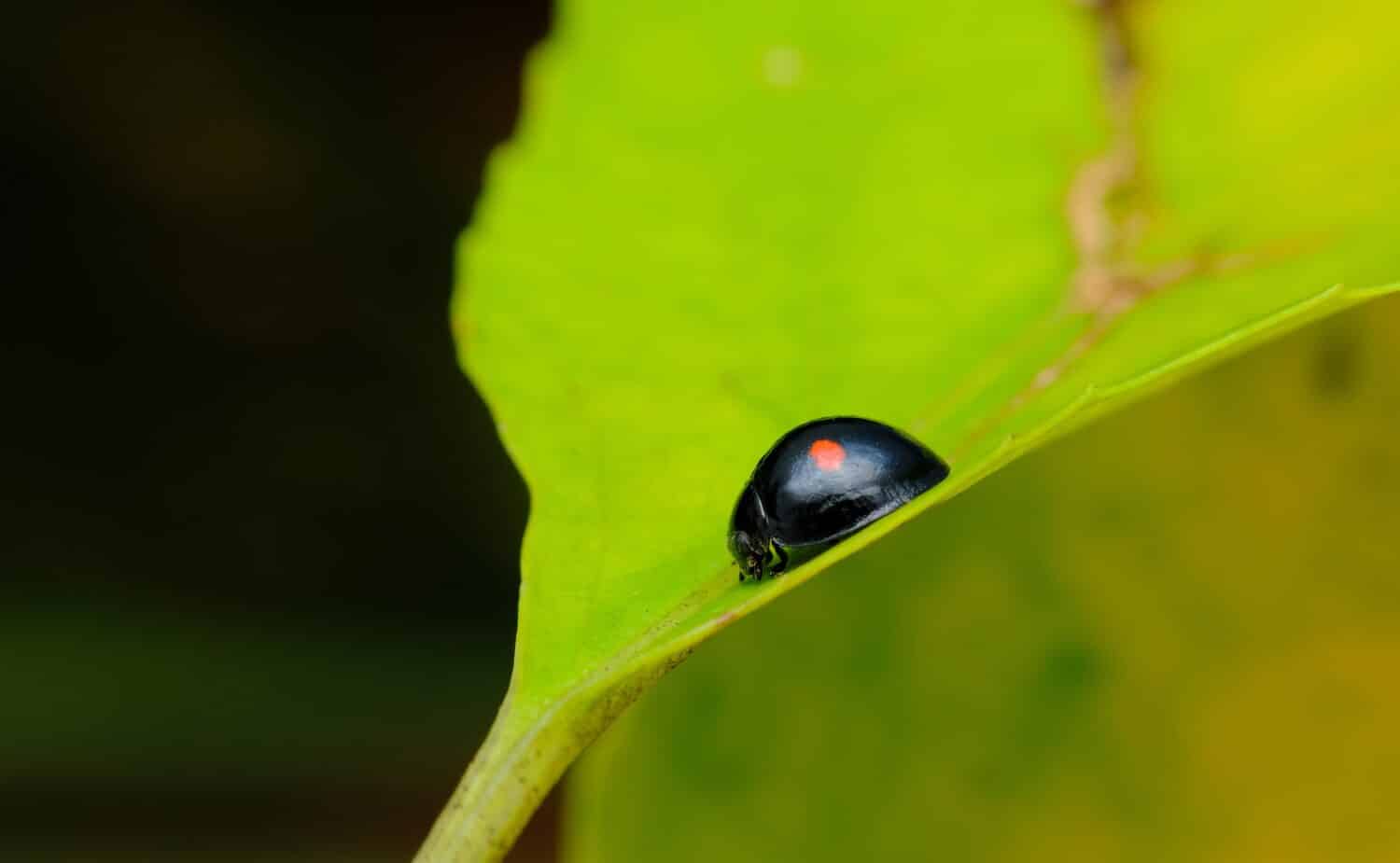
The twice-stabbed lady beetle is black with two red spots.
©Ezume Images/Shutterstock.com
8. Orange
Orange is a common color among ladybugs. One example of an orange ladybug is the nine-spotted ladybeetle (Coccinella novemnotata), which is typically pale orange with black spots. Since 1989 the nine-spotted lady beetle has been the state insect of New York.
Unfortunately, this insect’s population has been declining and was even thought to be extinct in the state at one point. Luckily in 2011, the nine-spotted lady beetle was rediscovered in the state once again, alive and well according to CBS New York.
Other species of ladybug that may have orange and black coloring include the ten-spotted ladybird, convergent lady beetle (Hippodamia convergens), and thirteen-spotted lady beetle (Hippodamia tredecimpunctata).
The transverse ladybird (Coccinella transversalis) is typically bright orange with a unique pattern of black splotches. They are often found in India, southern Asia, and Australia.
Asian Lady Beetles
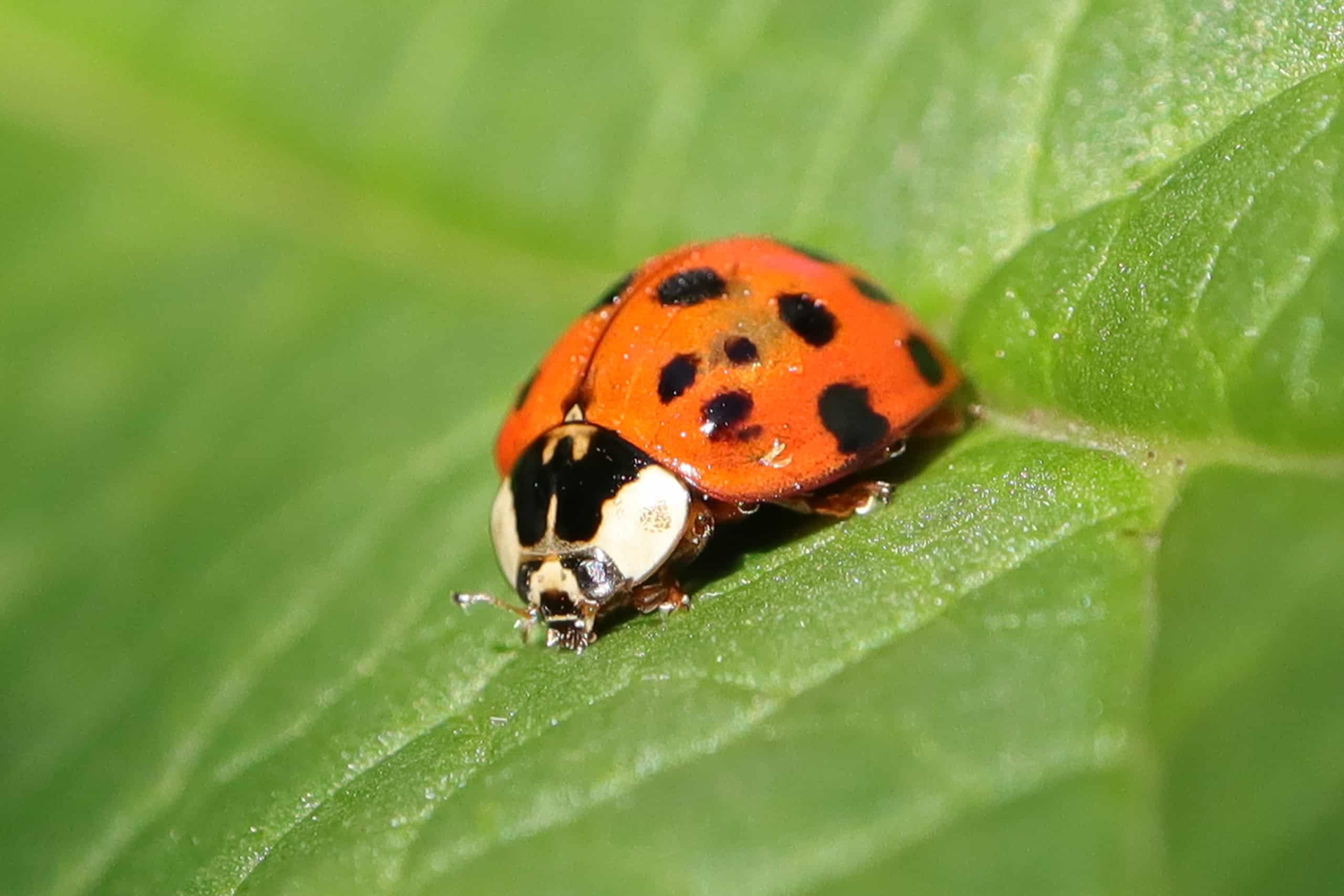
The Asian ladybeetle is considered an invasive species.
©iStock.com/DE1967
Asian ladybeetles (Harmonia axyridis) may look like orange ladybugs, but as any pest control specialist will tell you, they are not the same. They are typically orangeish brown in color with black spots. They are an invasive species that may actually eat ladybugs and their young.
Asian lady beetles have also been pushing out native ladybug species, according to Better Homes and Gardens. These creatures can congregate on the sides of houses and windows in huge numbers in the fall and even invade the inside of homes.
9. Yellow
Yellow is one of the most common colors for ladybugs. Several species share this bright coloring. The fourteen-spotted ladybeetle (Propylea quatuordecimpunctata) can be a variety of colors, from cream to yellow to light orange.
Its spots are the typical black color but have an interesting, almost rectangular shape. Additionally, the creature’s spots tend to be connected to one another. This helps to distinguish it from the 22-spot ladybug (Psyllobora vigintiduopunctata), which is bright yellow in color with rounder, separated black spots.
A unique species with yellow coloring is the yellow-shouldered ladybird (Apolinus lividigaster). This creature is mostly black in color, with two bright yellow spots on either side of its prothorax.

The 22-spot ladybird is yellow in color with round black spots.
©marcinswiostek/Shutterstock.com
10. Red
Though there are thousands of species of ladybug, the one that probably jumps to your mind first is the seven-spotted ladybug (Coccinella septempunctata). This creature is one of the most common species. It is typically red with seven black spots. Other ladybugs such as the two-spot ladybug and spotless ladybeetle are commonly red.
The ladybug was originally named in reference to a very important lady in many religions. That lady is the Virgin Mary, mother of Jesus. According to Merriam-Webster, the common ladybug’s seven spots symbolize the Virgin Mary’s seven sorrows.
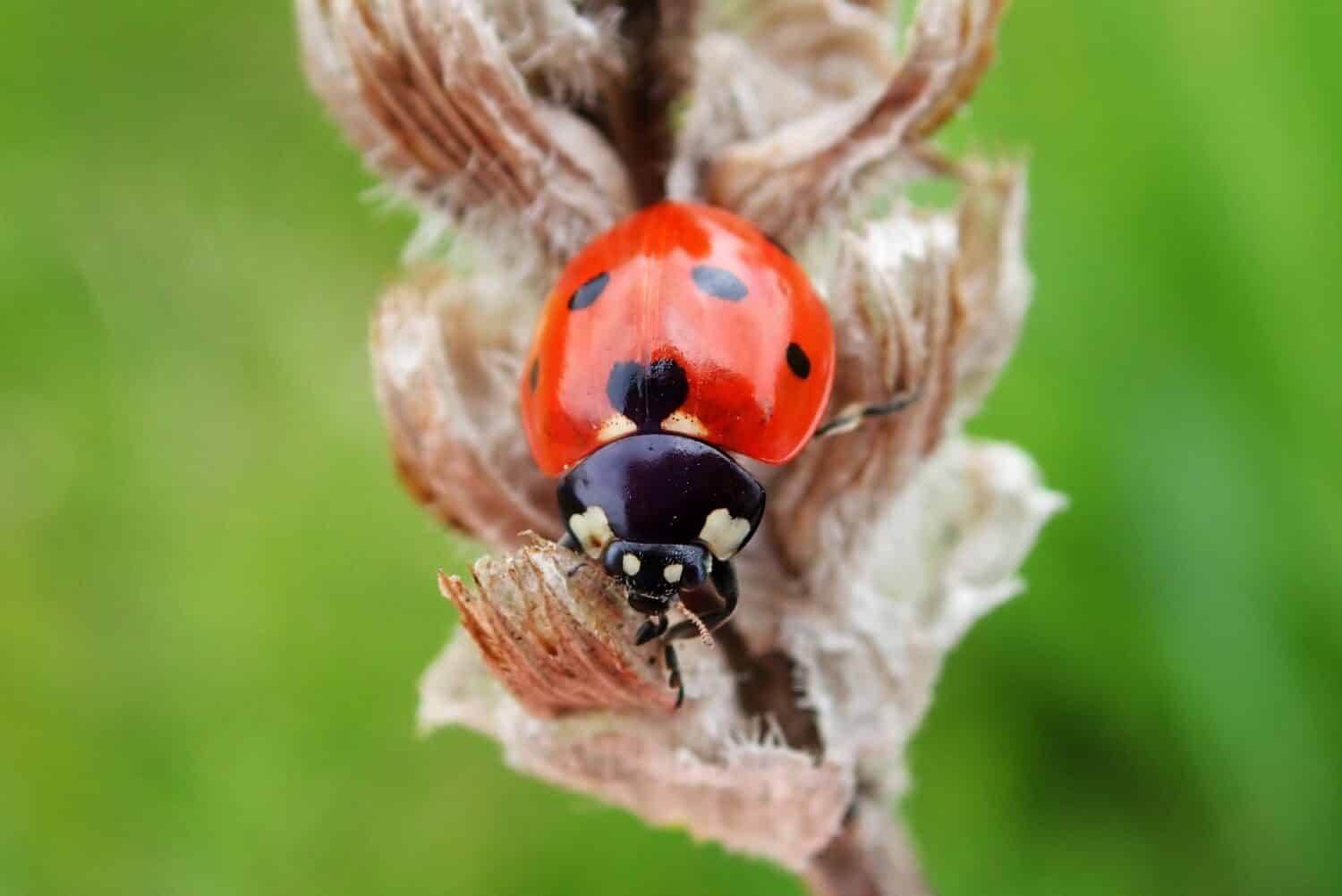
The seven-spotted ladybug is one of the most common species in the world.
©Vojce/Shutterstock.com
Summary of Ladybug Colors from Rare to Common
| Color | Ladybug Species |
|---|---|
| Tan | Winton’s Ladybird Beetle |
| White | 15-Spotted Ladybug, 20-Spotted Ladybug, Cream-Spot Ladybug |
| Gray | Ashy-Gray Ladybeetle |
| Pink | Pink Spotted Ladybeetle |
| Blue | Steelblue Ladybug |
| Brown | Larch Ladybug, Pine Lady Beetle, Rhyzobius chrysomeloides |
| Black | Twice-Stabbed Ladybeetle |
| Orange | Nine-Spotted Lady Beetle, Ten-Spotted Ladybird, Convergent Lady Beetle, Thirteen-Spotted Lady Beetle, Transverse ladybird |
| Yellow | 14-Spotted Lady Beetle, 22-Spot Ladybug, Yellow-Shouldered Ladybird |
| Red | Seven-spotted Ladybug, Two-Spot Ladybug, Spotless Ladybeetle |
The photo featured at the top of this post is © Oakland Images/Shutterstock.com
Thank you for reading! Have some feedback for us? Contact the AZ Animals editorial team.



